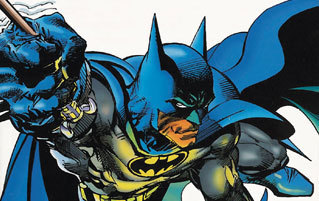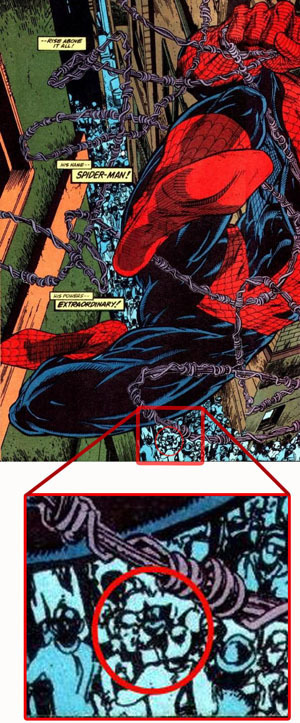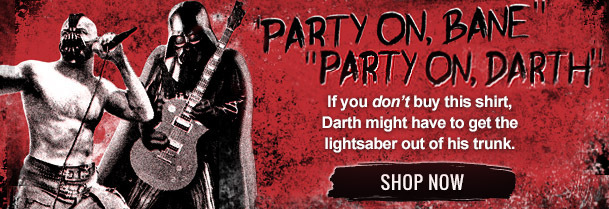5 Mind-Blowing Easter Eggs Hidden in Famous Publications

If you're a longtime reader, you know we've got a thing for Easter eggs -- those little hidden clues in movies/books/games that the creators seemingly inserted purely so that they would never be found. Maybe it's because writers and artists get bored, or maybe they know that years down the road someone like us will come along and draw them out ...
Watchmen Had an Entirely Symmetrical Chapter

Alan Moore, the coked-out great-uncle of the comic book world, is famous for his painstaking attention to detail -- his stories are so loaded with hidden messages that you're kind of wasting your money reading them just once. Watchmen, for example, is chock-full of literary allusions and historical in-jokes that you probably missed because you were too busy snickering at your own zingers about Doctor Manhattan's blue balls. But even if you pride yourself on having caught every single reference to 18th century Romantic poetry, none of that holds a candle to the fifth chapter's entirely symmetrical layout.
To demonstrate, here's the centerfold of the book:

Sorry, no boobs in this centerfold.
Notice how the panels reflect each other, with three on the left, three on the right, and the middle bisecting at the page break? Well, the entire 28-page issue is like that -- Page 1 mirrors Page 28, Page 2 mirrors Page 27, and so on, until the mirror syncs up at the centerfold.
Think of the effort, the sheer amount of planning Moore and artist David Gibbons had to do to make that possible. Now forget it, because it's nothing compared to what's coming next: Not only are all the panel layouts symmetrical, but the matching pages follow the same stories and characters. For instance, the first six pages of the issue show Rorschach breaking into Moloch's house; the last six pages show him breaking out of it. On Page 7, cops investigate a murder; they don't show up again until Page 22, its mirror twin.

Poster Buddha spends a lot of time in reflection.
Crazy, right? But it's not quite Alan Moore crazy yet. To give it that extra nudge over the Cliffs of Insanity, not only are the pages mirrored, not only do they follow the same characters and storylines, but the images in the panels are often mirrored as well. In the fourth panel of Page 10, Dan (Nite Owl) is in the foreground on the far left, with Laurie (Silk Specter) in the background. On the mirrored page, Laurie is on the far right, with Dan in the background.

It starts with Dan eating chicken and ends with him going to choke it.
On Page 8, the bottom panels show purple triangles on a pink background; the "reflected" page shows pink triangles on a purple background.

That's so cool, we're not even going to talk about the pirate turning a shark into a boat.
And lastly (also, firstly), the first and last pages of the chapter form a red X, referencing the skull and crossbones from the chapter's cover.

A comic with so many layers, even the spoilers are subliminal.
And with that, we've officially hit the level of borderline-demented detail that Moore revels in forcing you to break out your magnifying glass and spend an inordinate amount of time discovering. Of course, you could've taken a hint sooner by paying closer attention to the chapter's title -- "Fearful Symmetry" -- but where's the fun in that?
Todd McFarlane Hid Felix the Cat in Every Comic Book He Drew

Todd McFarlane frequently bumped into a man at his local comic book shop who, at the slightest provocation and presumably in his very best Comic Book Guy voice, would repeatedly inform him that he didn't purchase any of McFarlane's comics because he wasn't into superheroes (McFarlane, in case you're not familiar with the name, is best known for his work on Spider-Man and Spawn). Noticing that the man carried a Felix the Cat doll with him wherever he went, McFarlane utterly failed to do the prudent thing -- namely, hitting 911 on his cellphone and keeping his thumb poised over the call button -- and instead asked him, "If I put Felix the Cat in my comics, would you buy them then?"
The man answered yes, so McFarlane did just that -- he put Felix the Cat into every single comic he drew from that point on. In Spider-Man #1, Felix's grinning visage can be found in the crowd directly below Spidey's either comically muscular or elephantiasis-ridden left thigh:

Going as Spider-Man villain Felix Hardy, aka the Black Cat.
In #2, he's on the label of a jar of obscenely red jelly (don't think about it too much because it gets disturbing):

Still less disgusting than cat nut butter.
In #3, he's on the sign atop a taxi (first panel):

A Broadway musical ad, foreshadowing Spider-Man's tragic future.
Skip to #5, and he's ... oh, it's the taxi again. Hey, how about you try sneaking a famous cartoon cat into every single thing you create and we'll see how long it takes you to hit a repeat, huh, smart guy?

Three issues in a cab, 'cause rush hour's a bitch.
This could go on and on ad infinitum, but you get the idea. We're not sure if McFarlane is an Olympic-level smartass or if he's still sorting through some issues stemming from relentless teasing by his peers when he once reneged on a double-dog dare as a child, but either way his level of commitment to proving himself to some random dude with a cat doll is almost as impressive as said dude's comic book collection must be by now.
Rupert Murdoch Got Stealth-Dissed (in a Newspaper Owned by Rupert Murdoch)

We've all worked for a boss we hated, or at the very least thought was kind of a dick. And chances are you've spent at least a little time daydreaming about how to passive-aggressively get revenge on your bosses in just such a way that you can secretly laugh behind their backs for the rest of your life (or at least your employment) without them ever figuring out who was behind it.

"Did you get my latte?"
"Yup."
But what if you worked for, say, Australia's best-selling newspaper and your boss was, say, Rupert Murdoch, the man who basically controls the print and TV output of five continents? In that case, it would take balls of truly stellar proportions to try to pull off something like that.
Well, there appears to be a solar system forming around a certain sneaky editor's "binary stars" as we speak, because he or she did precisely that. The puzzlemaster (apparently not something out of an '80s fantasy movie starring David Bowie) chose to hide their message in the one section of the Sunday Telegraph that adults tend to flip right past: the ultra-cleverly named kids' section, the Funday Telegraph.

"OK, so I sneaked in a reference to my band, Live Sihco Drum. Big deal."
In case your Led Zeppelin-ese is rusty, the third line of Harry the Dog's word search puzzle read backward spells "MURDOCH IS EVIL." Not only did this slam on the big boss man go unnoticed by the paper's editing team, but it wasn't until two days after the edition was printed that the public noticed it at all, possibly while someone was wrapping a fish in it. But as soon as they did notice, damned if Twitters everywhere didn't explode about it -- with the exception of one Mr. Rupert Murdoch's, which remained stoically tweet-free for days afterward.
The Telegraph refused to comment on the matter, and it appears that the guilty puzzle maker is still unidentified. We're sure that's just to protect their privacy and not because they've conveniently disappeared or anything.
Every Issue of The Brave and the Bold Revealed Who Would Team Up With Batman in the Next Issue

For much of its run (Issues #74 to #200), The Brave and the Bold was a classic team-up book pairing everyone's favorite flying-mammal-themed superhero with other, less-flying-mammally superheroes in the DC universe. Half the fun of such a title lies in the anticipation of that moment when you first see the cover of the new issue and find out who'll be kicking ass and taking names alongside the Caped Crusader that month -- a lingering unknown right up until that very moment; a mystery solvable by only the creative minds behind the stories. Or, you know, by any fan crazy bored enough to scour every last panel of the previous issue to track down the spoiler hidden in each one.
In this panel from Issue #177, see that shadow to the immediate right of Elongated Man (no shit, that's his actual superhero name)? That's the silhouette of the one and only Creeper.

So, two creepers in this scene then.
In Issue #178, there's a single panel that appears to show a spaceship zooming across a full moon:

Or the moon's a fan of Morpheus shades.
Disappointingly, that's not foreshadowing an epic tag-team match featuring Bruce Wayne and Captain Kirk -- that there is a Legion cruiser, home base of the Legion of Super-Heroes.
But the clues weren't always quite so easy to spot. In #180, if you look closely at the psychedelic waves emanating from what appears to be the spectral realm's butthole, you'll see the (apparently agonized) likenesses of Hawk and Dove:

Also a reference to how shitty Hawk and Dove are.
And then, in the Hawk and Dove issue, here's the tiny insignia made famous by a certain Boy Wonder on the side of a trolley car ...

Raffi?
... signifying that Batman and Robin would be teaming up in the next issue. Because that's a duo the world's never seen before.
But when it comes to foreshadowing, we're guessing no Easter egg in the history of the written word will ever top this one ...
Military Code Words for the D-Day Invasion Were Hidden in a Crossword Puzzle

There's no questioning the fact that World War II's D-Day invasion is one of history's most recognizable events -- after all, the Dieppe Raid never landed itself a Spielberg blockbuster (it was more along the lines of a Monty Python skit). So it's not unusual that, back in 1944, U.K. newspaper the Telegraph's daily crossword puzzle featured "Utah" -- the now-famous code name for the beach invaded by the 4th U.S. Assault Division -- as one of its solutions.
But here's the thing: The code word wasn't famous at the time, as that puzzle was published a full month before the Normandy landings.

Weirder still, Utah wouldn't even become a state until 1973.
Still, you could chalk that up to coincidence, right? Sure you could ... right up until, less than three weeks later, another crossword featured a solution of "Omaha" -- aka "the code for the beach to be taken by the 1st U.S. Assault Division." Then, five days after that, it was "overlord" -- the code name for the entire D-Day operation. Three days after that, it was "Mulberry" -- the floating harbors that puked streams of soldiers onto the beaches of Normandy.
Finally, on June 1, 1944 -- still five days before D-Day -- came "Neptune," the aptly named naval assault phase of the invasion. And that, ladies and gentlemen, is when the bright red phone at MI5 headquarters started ringing off the hook.

Possibly because forcing crossword puzzlers to come up with "bivouac" is a war crime.
When MI5 agents stormed the home of Telegraph crossword compiler Richard Dawe and gave him the ol' once over (we're picturing lots of harrumphing accentuated by billy clubs), they soon left ... puzzled. The whole thing seemed to be an inconceivably unlikely coincidence. And that puzzlement lasted 40 years, until Ronald French finally stepped forward with an explanation for the seemingly prophetic crossword clues. You see, Dawe was also a school headmaster (apparently designing crossword puzzles isn't exactly lucrative), and he sometimes had students populate the words into blank crossword patterns, presumably as some kind of sadistic detention punishment. Ronald French was one of said students, and when he wasn't spending time in Dawe's study slaving over crossword grids, he was hanging out with the Allied troops stationed nearby, just, you know, driving tanks and shit.
French was obsessed with the soldiers' activities and sponged up their banter like ... well, like a 14-year-old boy who got to play soldier with actual freaking soldiers. The code words found their way out of the terrifying maze that is a pubescent boy's psyche and into the crossword. And that, kids, is how what at first appeared to be the work of a Nazi spy using a convoluted crossword puzzle plot to snitch valuable wartime information to his superiors instead turned out to be a clever Easter egg inserted by a random teenager.
Robert is a columnist for Freakin' Awesome Network and would like you to follow him on Twitter. Veronica draws a diary and has a Twitter.
For more awesome easter eggs you probably missed, check out 24 REAL R-Rated Easter Eggs Hidden in Famous Pop Culture.
Related Reading: While we're on the subject of Easter Eggs, did you know all the characters who die in The Departed were visibly marked? Even the Internet has easter eggs, and our forums have found the craziest ones. If you prefer your surprises buried in famous TV shows, click right here.
